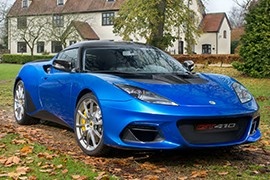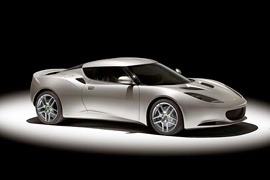
LOTUS Evora
Generations Timeline, Specs and Pictures

The British company, Lotus, started back in the 50s and ever since, it has only produced racing and sports cars.
All of their models’ names start with the letter “E” and the Evora nameplate has been around for over a decade.
Compared to the older versions, the new Evora was faster, sharper and more appealing than ever, with its badass racer look.
Could it be driven daily? Of course, if the fuel consumption was not a problem. The car was still a 2+2 and the British made everything possible to provide a comfortable ride, as comfortable as it could get for a vehicle that performed on the track as beautiful as a bird in the air.
The interior of the Evora was cozy, with Alcantara all around and carbon fiber elements. It had heated Sparco bucket seats and what made it so different from other cars produced in the EU, the unconventional buttons that were placed way up in the dashboard.
The sports car had a limited slip differential, a selectable drive mode and featured a Bilstein suspension. It was one of the cars that required the driver’s 100% involvement due to the amazing brakes and precise steering.
With great power comes great noise and vice verse, right? Well, not always, but it’s a “yes” for this one. The 3.5-liter V6 engine roared loudly and the sound entered the cabin, thus music was out of the question.
The beautiful V6 engine produced 410 hp and was mated with either an automatic or a manual transmission, rocketing to 100 kph in 3.9 seconds with the automatic gearbox and in 4.0 seconds with the manual one.

The first all-new Lotus since the British carmaker released the Elise in 1995, the Ever was unveiled in 2008 at the British Auto Show as the world’s only mid-engine 4 seater.
Designed for customers looking for exclusivity and rarity, the sports car was produced in a maximum of 2000 units a year. crafted at Lotus’ manufacturing facility in Hethel.
The exterior design inspired agility and sophistication, with muscular rear haunches and low and wide forward proportions. While the design made it clear that it was a Lotus by maintaining some of the well-known styling cues, the Evora distinguished itself with the undulating shoulder line.
Inside, unlike the minimalist racing-car-oriented design Lotus used us with, the Ever had a more sophisticated and softer approach, using high quality materials providing a luxurious ambience.
With breathtaking performance, the Evora featured a tweaked Toyota engine, a 3.5-liter V6 unit that produced 280 hp. With a body weight of only 1350 kg, the Ever could sprint to 100 kph in less than 5 seconds.
The Japanese grip masters Yokohama partnered with Lotus and developed bespoke tyres especially for the Evora, the sports car featuring 22/40/18 at the front and larger 255/35/19 at the rear. The sidewalls of the tyres wore the LTS badges.

The British car-manufacturer Lotus has revealed a new supercar built for the public roads but with even greater abilities on the track: the Evora GT.
Lotus was always connected to the high-performance and nimble cars. For a long time, it wasn’t that important on the market anymore, until it revealed the Elise, the car that changed everything. Its basic principles of light vehicle and powerful engines worked very well, especially for those who were heading down the racetrack for weekend races.
Based on the already known Lotus Evora, the GT version was introduced in 2019 as a 2020 model. The GT was based on the Evora 4. First of all, the GT is lighter than the 400. One of the reasons is that it was available with 2, or 2+2 seating configuration. An expensive Carbon Pack was included on the options list and that shaved up to 100 lbs (45 kg) from the vehicle weight. The new carbon-fiber body panels also added aerodynamic downforce for improved high-speed cornering grip.
Inside, the GT letters are embroiled in the seatbacks just to remember that it was the GT version. On the center console, in front of the gear-stick, there were the climate control rotary knobs that looked like those used for radio-communication in a race-car. In the middle of the dashboard, an Alpine infotainment unit with Apple CarPlay and Android Auto connectivity was installed.
The engine was the same supercharged 3.5-liter from Toyota that was installed on the Evora 400. It was tweaked to produce more power. The transmission was made via a 6-speed manual gearbox and a Torsen limited-slip differential.

Lotus probably had a “keep-it-light” banner in their cafeteria that made them take the newly introduced Evora 400 and turned it into the 410 model.
In March 2016, the British carmaker unveiled a new version of the Evora model. Its engineers burned the midnight oil and consumed gallons of coffee to find new ways to reduce the car’s weight. They shaved 70 kg (154.3 lbs) from the Evora 400.
Lotus’ design team had an even more challenging job making the car look different without adding more weight. They replaced the aerodynamic package with a carbon-fiber one. That included the front splitter, the roof, tailgate, and rear diffuser, and they left all of these unpainted. The engine cover incorporated a louvered section, inspired by some of the company’s most famous heritage models. With the new rear carbon-fiber panels, the new aerodynamic package improved the car’s downforce by 15% with no increase in drag.
Inside, the sport bucket-seats with high bolstering were based on a carbon-fiber frame. They were padded with Alcantara. The same material was used for the steering wheel and the center console. For the infotainment system, Lotus introduced a new device that featured iPod and Bluetooth connectivity. Other weight-saving methods included the deletion of door armrests and storage pockets.
Under the hood, Lotus’ engineers squeezed ten more ponies from the Toyota-sourced V-6 engine. They paired it to a six-speed manual with a light flywheel and sent the power to the rear wheels via a limited-slip differential.

After a 7-year run, Lotus’ flagship finally got replaced in 2015.
The new Evora 400 got to continue from where the older model left off while improving both the sportscar’s image and specs sheet. It’s not a whole new model though, but a very intricate facelift to the original Evora.
The exterior isn’t drastically changed, but it does come with new bumpers, rims and paint schemes that make the Evora 400 look edgy and contemporary. The front end is more gaping and also houses LED daytime running lights, while the rear got more chiseled, two extra side vents and a redesigned wing.
On the other side, the interior is completely redone, coming with a remodeled dashboard, seats, door cards, central console, and a new steering wheel with shortcut buttons. A new infotainment system is also on the list of changes.
Mechanically is the part where the Lotus Evora 400 amazes, being 6 seconds faster than the generation before on the Nurburgring. That’s because the car is 22 kilos lighter, offers more power and comes with a revised suspension.

After the successful Evora 400 and 410, the British sports car manufacturer Lotus introduced in 2017 their fastest version to date, the GT430.
Lotus was known for building light and very light sports cars. Their engineers didn’t hunt hundreds of horsepower, but they were keen to cut down the weight of their vehicles. For some models, even the interior carpets were offered as an option.
The exterior look of the GT430 is as aggressive as it can be with a big air intake in the center of the front bumper and two air-scoops on the sides to cool the brakes. On the hood, two extracting scoops were installed to help for cooling the radiators placed in the front. On top of the front fenders, a pair of vents helped to reduce the lift from the wheel-well.
Inside, the minimalist design was dominated by sport-bucket seats built on carbon-fiber support. The infotainment system installed on the dashboard was the only modern feature that was on sight. There were few buttons and switches on the center console some simple buttons from Renault car manufacturer and that was it. The only fancy feature was the Alcantara on the dashboard. But that was there to remove the glare and the reflections into the windshield.
Under the hood, there was the same Toyota V6 unit installed in other Lotus cars. It featured an Edelbrock supercharger that boosts the power up to 430 hp and without any turbo-lag. The engine was mated as standard to a 6-speed manual or, as an option, a 6-speed automatic. A limited-slip differential was installed to improve traction and the ESP could be calibrated to allow different slip percentages.























































